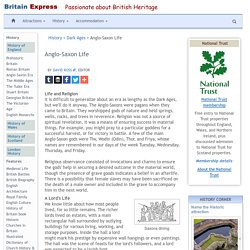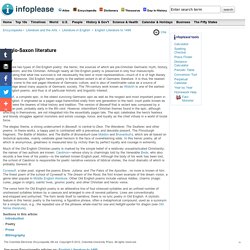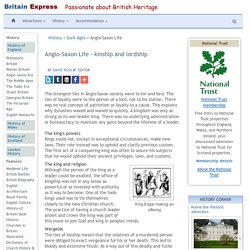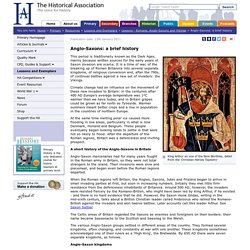

Anglo-Saxon life. Life and Religion It is difficult to generalize about an era as lengthy as the Dark Ages, but we'll do it anyway.

The Anglo-Saxons were pagans when they came to Britain. They worshipped gods of nature and held springs, wells, rocks, and trees in reverence. Religion was not a source of spiritual revelation, it was a means of ensuring success in material things. For example, you might pray to a particular goddess for a successful harvest, or for victory in battle. Anglo-Saxon Society Characteristics and Values flashcards. Characteristics of Anglo-Saxon Poetry flashcards. Anglo-Saxon literature: Prose. Old English literary prose dates from the latter part of the Anglo-Saxon period.

Prose was written in Latin before the reign of King Alfred (reigned 871–99), who worked to revitalize English culture after the devastating Danish invasions ended. As hardly anyone could read Latin, Alfred translated or had translated the most important Latin texts. He also encouraged writing in the vernacular. Didactic, devotional, and informative prose was written, and the Anglo-Saxon Chronicle, probably begun in Alfred's time as an historical record, continued for over three centuries. Two preeminent Old English prose writers were Ælfric, Abbot of Eynsham, and his contemporary Wulfstan, archbishop of York.
Anglo-Saxon Culture. Michael Delahoyde Washington State University History: When Rome was weakening early in the fifth century c.e., troops in the outlying regions, including the British Isles, were withdrawn.

Walls, roads, and baths remain even now. They also left the native Celts and Celtic-speaking Britons somewhat christianized, and Picts and Scots in the north, but "political" power fell to unstable tribal units. One of these leaders, Vortigern, "invited" Angles, Saxons, and Jutes to join his military power, so the land saw a swell of invasions by Jutes -- a germanic tribe from Denmark -- in 449, followed soon by Angles and Saxons. (The current name originates as "Angle-Land. ") The Anglo-Saxon social structure consisted of tribal units led by chieftains ("kings," or "lords") who, theoretically at least, earned their respect from their warriors (or "retainers," or "thanes," the group being called a "comitatus"). Anglo-Saxon literature: Poetry. There are two types of Old English poetry: the heroic, the sources of which are pre-Christian Germanic myth, history, and custom; and the Christian.

Although nearly all Old English poetry is preserved in only four manuscripts—indicating that what has survived is not necessarily the best or most representative—much of it is of high literary quality. Discribe the features of Anglo-Saxon Poetry in detail. - Homework Help. The poetry of the Anglo-Saxons is defined by the following characteristics: 1.

Anglo-Saxon poetry is written in blank verse. The term blank verse means that there is no end rhyme occurring from line to line. 2. Anglo-Saxon Poetry: Characteristics & Examples. In this lesson, we will review the general history of Anglo-Saxon society and its era.

Then, we will look closer at the characteristics of the literature, specifically the poetry, of that era. Explore our library of over 10,000 lessons Click "next lesson" whenever you finish a lesson and quiz. Got It You now have full access to our lessons and courses. Anglo-Saxon England - culture and society. The strongest ties in Anglo-Saxon society were to kin and lord.

The ties of loyalty were to the person of a lord, not to his station. There was no real concept of patriotism or loyalty to a cause. This explains why dynasties waxed and waned so quickly. A kingdom was only as strong as its war-leader king. There was no underlying administration or bureaucracy to maintain any gains beyond the lifetime of a leader. The king's powersKings could not, except in exceptional circumstances, make new laws. King Edgar making an offering The king and religionAlthough the person of the king as a leader could be exalted, the office of kingship was not in any sense as powerful or as invested with authority as it was to become. WergeldsThe ties of kinship meant that the relatives of a murdered person were obliged to exact vengeance for his or her death. This emphasis on social standing led to an interesting court system.
Anglo-Saxon. Anglo-Saxon, term used historically to describe any member of the Germanic peoples who, from the 5th century ce to the time of the Norman Conquest (1066), inhabited and ruled territories that are today part of England and Wales.

According to St. Bede the Venerable, the Anglo-Saxons were the descendants of three different Germanic peoples—the Angles, Saxons, and Jutes. By Bede’s account, those peoples originally migrated from northern Germany to the island of Britain in the 5th century at the invitation of Vortigern, a ruler of Britons, to help defend his kingdom against marauding invasions by the Picts and Scotti, who occupied what is now Scotland. Archaeological evidence suggests that the first migrants from the Germanic areas of mainland Europe included settlers from Frisia and antedated the Roman withdrawal from Britain about 410 ce.
Anglo-Saxons: a brief history. Publication date: 13th January 2011 King Arthur as one of the Nine Worthies, detail from the 'Christian Heroes Tapestry' This period is traditionally known as the Dark Ages, mainly because written sources for the early years of Saxon invasion are scarce.

It is a time of war, of the breaking up of Roman Britannia into several separate kingdoms, of religious conversion and, after the 790s, of continual battles against a new set of invaders: the Vikings. Climate change had an influence on the movement of these new invaders to Britain: in the centuries after 400 AD Europe's average temperature was 1°C warmer than we have today, and in Britain grapes could be grown as far north as Tyneside. Warmer summers meant better crops and a rise in population in the countries of northern Europe. At the same time melting polar ice caused more flooding in low areas, particularly in what is now Denmark, Holland and Belgium. History - Ancient History in depth: The Anglo-Saxons.